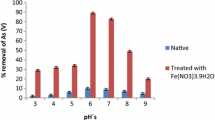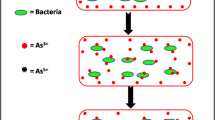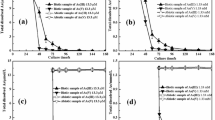Abstract
This paper evaluates heterotrophic leaching of arsenic (As) pre-adsorbed onto amorphous ferric oxyhydroxides (FeOx) and its subsequent biovolatilization under laboratory conditions during Aspergillus niger static cultivation. With initial 90 mg.L−1 As concentration and absence of FeOx, the biomass As accumulation capacity attained 1.4 mg.g−1 on the 15th day of cultivation. While FeOx suppressed As biomass accumulation up to 0.23 mg.g−1, it did not influence biovolatilization activity. After 15-day cultivation, almost 1.8 mg As was released into the surrounding culture media, accumulated and subsequently transformed into its volatile derivatives, regardless of FeOx presence or absence. The A. niger strain was able to enhance As release from the FeOx surfaces; the total As medium concentration increased to 3.1 mg.L−1 on the 15th cultivation day, and this amount was considerably higher than the 0.128 mg.L−1 As concentration leached from FeOx in fungal absence. These observations indicate that complex mutual interactions between As immobilized in FeOx and filamentous fungi are environmentally significant regarding As mobility and transformation in oxic environments.






Similar content being viewed by others
References
Bačík, P., Ozdín, D., Miglierini, M., Kardošová, P., Pentrák, M., & Haloda, J. (2011). Crystallochemical effects of heat treatment on Fe-dominant tourmalines from Dolní Bory (Czech Republic) and Vlachovo (Slovakia). Physics and Chemistry of Minerals, 38, 599–611.
Bujdoš, M., Kubová, J., & Streško, V. (2000). Problems of selenium fractionation in soils rich in organic matter. Analytica Chimica Acta, 408, 103–109.
Burgstaller, W., & Schinner, F. (1993). Leaching of metals with fungi. Journal of Biotechnology, 27, 91–116.
Charlet, L., Chakraborty, S., Appelo, C. A. J., Roman-Ross, G., Nath, B., Ansari, A. A., et al. (2007). Chemodynamics of an arsenic “hotspot” in a West Bengal aquifer: a field and reactive transport modeling study. Applied Geochemistry, 22, 1273–1292.
Cullen, W. R., & Reimer, K. J. (1989). Arsenic speciation in the environment. Chemical Reviews, 89, 713–764.
Edvantoro, B. B., Naidu, R., Megharaj, M., Merrington, G., & Singleton, I. (2004). Microbial formation of volatile arsenic in cattle dip site soils contaminated with arsenic and DDT. Applied Soil Ecology, 25, 207–217.
Gadd, G. M. (2004). Microbial influence on metal mobility and application for bioremediation. Geoderma, 122, 109–119.
Garcia-Sanchez, A., & Alvarez-Ayuso, E. (2003). Arsenic in soils and waters and its relation to geology and mining activities (Salamanca Province, Spain). Journal of Geochemical Exploration, 80, 69–79.
Ghimire, K. N., Inoue, K., Yamaguchi, H., Makino, K., & Miyajima, T. (2003). Adsorptive separation of arsenate and arsenite anions from aqueous medium by using orange waste. Water Research, 37, 4945–4953.
Hagarová, I. (2007). Speciation of arsenic in waters by AAS techniques. Chemicke Listy, 101, 768–775.
Hosseini, M. R., Pazouki, M., Ranjbar, M., & Habibian, M. (2007). Bioleaching of iron from highly contaminated Kaolin clay by Aspergillus niger. Applied Clay Science, 37, 251–257.
Jernejc, K., & Legiša, M. (2004). A drop of intracellular pH stimulates citric acid accumulation by some strains of Aspergillus niger. Journal of Biotechnology, 112, 289–297.
Kubicek, C., Punt, P., & Visser, J. (2011). Production of organic acids by filamentous fungi’. In M. Hofrichter (Ed.), Industrial applications (pp. 215–234). Berlin Heidelberg: Springer.
Lešková, A., Fargašová, A., & Molnárová, M. (2013). Phytotoxicity and bioaccumulation of arsenic in crops (Sinapis alba L., Triticum aestivum L., Hordeum vulgare L.). Fresenius Environmental Bulletin, 22, 832–838.
Maciaszczyk-Dziubinska, E., Wawrzycka, D., & Wysocki, R. (2012). Arsenic and antimony transporters in eukaryotes. International Journal of Molecular Sciences, 13, 3527–3548.
Magnuson, J. K., & Lasure, L. L. (2004). Organic acid production by filamentous fungi. In J. S. Tkacz & L. Lange (Eds.), Advances in fungal biotechnology for industry, agriculture, and medicine (pp. 307–340). New York: Springer.
Mukherjee, A. B., & Bhattacharya, P. (2001). Arsenic in groundwater in the Bengal delta plain: slow poisoning in Bangladesh. Environmental Reviews, 9, 189–220.
Nguyen, K. P., & Itoi, R. (2009). Source and release mechanism of arsenic in aquifers of the Mekong Delta, Vietnam. Journal of Contaminant Hydrology, 103, 58–69.
Nickson, R. T., McArthur, J. M., Ravenscroft, P., Burgess, W. G., & Ahmed, K. M. (2000). Mechanism of arsenic release to groundwater, Bangladesh and West Bengal. Applied Geochemistry, 15, 403–413.
Ruijter, G. J. G., Van De Vondervoort, P. J. I., & Visser, J. (1999). Oxalic acid production by Aspergillus niger: an oxalate-non-producing mutant produces citric acid at pH 5 and in the presence of manganese. Microbiology, 145, 2569–2576.
Santhiya, D., & Ting, Y.-P. (2006). Use of adapted Aspergillus niger in the bioleaching of spent refinery processing catalyst. Journal of Biotechnology, 121, 62–74.
Sayer, J. A., Kierans, M., & Gadd, G. M. (1997). Solubilisation of some naturally occurring metal-bearing minerals, limescale and lead phosphate by Aspergillus niger. FEMS Microbiology Letters, 154, 29–35.
Smedley, P. L., & Kinniburgh, D. G. (2002). A review of the source, behaviour and distribution of arsenic in natural waters. Applied Geochemistry, 17, 517–568.
Urík, M., Čerňanský, S., Ševc, J., Šimonovičová, A., & Littera, P. (2007). Biovolatilization of arsenic by different fungal strains. Water, Air, and Soil Pollution, 186, 337–342.
Acknowledgments
We thank Dr. Elena Piecková for providing Aspergillus niger fungal strain for this study. This work was financially supported by VEGA Nos. 1/0203/14 and 1/0263/15, and UK/175/2014.
Author information
Authors and Affiliations
Corresponding author
Rights and permissions
About this article
Cite this article
Urík, M., Bujdoš, M. & Milová, B. Biologically Induced Mobilization of Arsenic Adsorbed onto Amorphous Ferric Oxyhydroxides in Aqueous Solution During Fungal Cultivation. Water Air Soil Pollut 225, 2172 (2014). https://doi.org/10.1007/s11270-014-2172-x
Received:
Accepted:
Published:
DOI: https://doi.org/10.1007/s11270-014-2172-x




